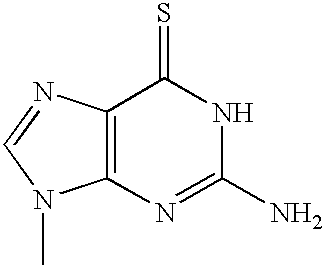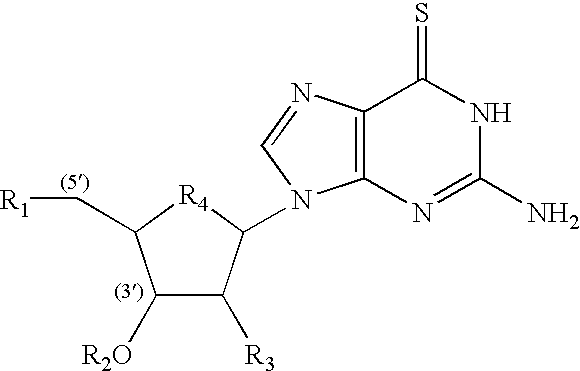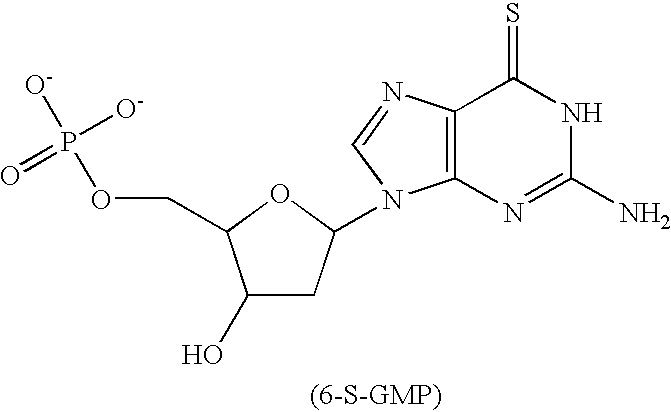Microelectronic device for electrochemical detection of nucleic acid hybridization
a micro-electronic device and nucleic acid technology, applied in the field of nucleic acid hybridization and sequencing, can solve problems such as disadvantages in techniques
- Summary
- Abstract
- Description
- Claims
- Application Information
AI Technical Summary
Problems solved by technology
Method used
Image
Examples
example 1
Measurement of Cyclic Voltammogram of RU(I)py)32+
[0105]The cyclic voltammograms of Ru(bpy)32+ with and without calf thymus DNA are shown in FIG. 1, with the catalytic enhancement produced by the multiple turnovers of oxidation of DNA by the oxidized form of the metal complex which are observed during a single voltammetric sweep. The voltammetry of any DNA-bound redox couple must be analyzed in terms of a square-scheme that relates the bound and unbound forms because the diffusion coefficient of DNA is much lower (i.e., 2.0×10−7 cm2 / s) than that of the metal complex (8.0×10−6 cm2 / s). This phenomenon generally leads to dramatically decreased currents for the hound form; however, at sufficient high ionic strength ([Na+]=0.8 M), binding of the metal complex is too weak to influence the current response. In this case, the current can be analyzed in terms of a simple EC′ mechanism.
Ru(bpy)32+→Ru(bpy)33+ (E)
Ru(bpy)33+ DNA→Ru(bpy)32++DNAox (C′)
example 2
Analysis of Cyclic Voltammograms
[0106]Cyclic voltammograms were analyzed by fitting the complete current-potential curves, with the background subtracted, using the DIGISIM™ data analysis package. The input parameters were E1 / 2 for the metal complex and the diffusion coefficients for the metal complex and the DNA, all of which were determined in separate experiments. Therefore, the sole parameter obtained from the fit was the second-order rate constant for equation 2, k=9.0×103 M−1s−1. This same rate constant was determined over a wide range of scan rates.
[0107]The rate constant for oxidation of DNA by Ru(bpy)33+ was confirmed in two separate experiments. First, square-wave voltammograms were used to obtain a pseudo-first-order kobs for equation 2 by fitting with the COOL™ algorithm. The COOL™ algorithm uses a fitting approach that is significantly different from DIGISIM™; nevertheless, plots of kobs against DNA were linear and gave a second-order rate constant k=8.2×103 M−1s−1, whi...
example 3
Analysis of Cyclic Voltammograms
[0108]If the driving force for electron transfer is significantly less than the reorganizational energy (λ), a plot of RT ln k versus driving force (when corrected for work terms associated with approach of the reactants) should yield a straight line with a slope of ½. The rate constants for oxidation of DNA by a number of Metal(bpy)33+ derivatives with different redox potentials are shown in Table 1 below.
[0109]Since Marcus theory describes the driving-force dependence of the electron-transfer rate, absolute rate constants can be analyzed in terms of the following equation:
k=νexp[−β(r−r0)]exp[−(ΔG+λ)2 / 4λRT]
where ν is the rate constant in the diffusion-controlled limit (1011 M−1s−1), r is the distance between reactant and product in the activated complex, r0 is the distance of closest approach of reactant and product, and β describes the influence of the intervening medium. Incorporation of the guanine donor into the interior of the double helix impos...
PUM
| Property | Measurement | Unit |
|---|---|---|
| pH | aaaaa | aaaaa |
| thickness | aaaaa | aaaaa |
| diffusion coefficient | aaaaa | aaaaa |
Abstract
Description
Claims
Application Information
 Login to View More
Login to View More - R&D
- Intellectual Property
- Life Sciences
- Materials
- Tech Scout
- Unparalleled Data Quality
- Higher Quality Content
- 60% Fewer Hallucinations
Browse by: Latest US Patents, China's latest patents, Technical Efficacy Thesaurus, Application Domain, Technology Topic, Popular Technical Reports.
© 2025 PatSnap. All rights reserved.Legal|Privacy policy|Modern Slavery Act Transparency Statement|Sitemap|About US| Contact US: help@patsnap.com



